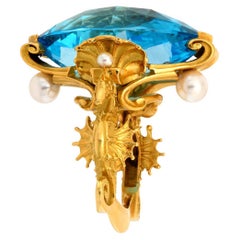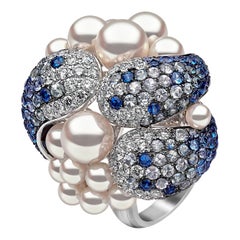Blue Akoya Pearl Ring
Recent Sales
2010s Australian Baroque Fashion Rings
Pearl, Topaz, Blue Topaz, Gold, Yellow Gold, 18k Gold
2010s British Contemporary Cocktail Rings
Diamond, White Diamond, Pearl, Cultured Pearl, Sapphire, Blue Sapphire, ...
2010s American Artisan Beaded Necklaces
Diamond, Pearl, Sterling Silver
Vintage 1920s Art Deco Cocktail Rings
Diamond, Pearl, Platinum
Blue Akoya Pearl Ring For Sale on 1stDibs
How Much is a Blue Akoya Pearl Ring?
The Legacy of Pearl in Jewelry Design
The pearl has been synonymous with ladylike elegance since the Tudor period — learn what to look for when shopping for vintage and antique pearl jewelry as well as how to tell the origin of a pearl with our handy primer.
Every woman at some point in her life desires a simple strand of pearls. They are elegant, timeless, versatile — just ask Coco Chanel or Jacqueline Kennedy — and valuable. In 1917, Pierre Cartier famously traded a double-strand of natural pearls for a Fifth Avenue mansion, the Cartier brand’s flagship store ever since. And if you were born in the beginning of summer, pearl is the June birthstone.
It is possible to tell where a pearl originated from its appearance. Akoyas are usually round and white — the classic pearl, if you will. South Sea pearls are normally larger and vary in color; orangey yellow ones are not uncommon. Tahitian pearls are mostly black but can also be gray or brown, and between the Akoya and the South Sea varieties in size. Freshwater pearls, or Orientals, run the gamut in terms of color and size, but in shape, they tend to resemble Rice Krispies. Another important distinction is a round pearl versus a baroque pearl. A round pearl is self-explanatory, but there are two types of baroque pearls: symmetrical and asymmetrical. In general, the symmetrical variation commands a higher valuation. Within a strand of pearls, uniformity is prized — the more the individual pearls resemble one another, the more valuable the strand.
According to the Gemological Institute of America (GIA), the earliest recorded mention of a pearl was in 2206 BC by a Chinese historian. Centuries later, Christopher Columbus made it a point to visit pearl fisheries during his 15th-century exploration of the Caribbean. Since the late-19th century, the Japanese have been at the forefront of cultivating pearls, when jeweler Kokichi Mikimoto successfully cultured the world’s first pearl in 1893.
On 1stDibs, find vintage and antique pearl necklaces, pearl earrings and other accessories.
Read More
This Absinthe-Hued Peridot Cocktail Ring Is Positively Intoxicating
Ancient Egyptians referred to the vibrant stone as the “gem of the sun.”
Our Guide to Engagement Ring Settings – And How to Choose One
There are many ways to showcase a diamond, from traditional prongs to a smooth, streamlined bezel. Here’s everything you need to consider.
Nothing Says Summer Heat Like This Ruby-Red Cartier Stunner
The vintage bombé ring is bursting with color and timeless style.
Zircon Rings: Our Guide to a Uniquely Colorful Natural Gemstone
Zircon is a magnificent and underrated natural gemstone that has been worn and adored for centuries.
[Survey] Two-Thirds of Jewelry Gift Recipients Don’t Want to Be Surprised
Givers of fine gems enjoy surprise more than receivers, and women more than men. Find out what else our survey of 3,000 Americans revealed.
Colorful Gemstones Are a Brilliant Choice for Engagement Rings
If diamonds don’t seem right, what about a magnificent sapphire, ruby or emerald?
Our Guide to Fancy-Colored Diamond Engagement Rings
Accounting for just 1 percent of all diamonds, these marvels of nature are exceedingly rare and gorgeously complex.
Our Guide to Victorian, Edwardian and Art Deco Engagement Rings
Learn about these antique jewelry styles, then choose a design that speaks to you.

